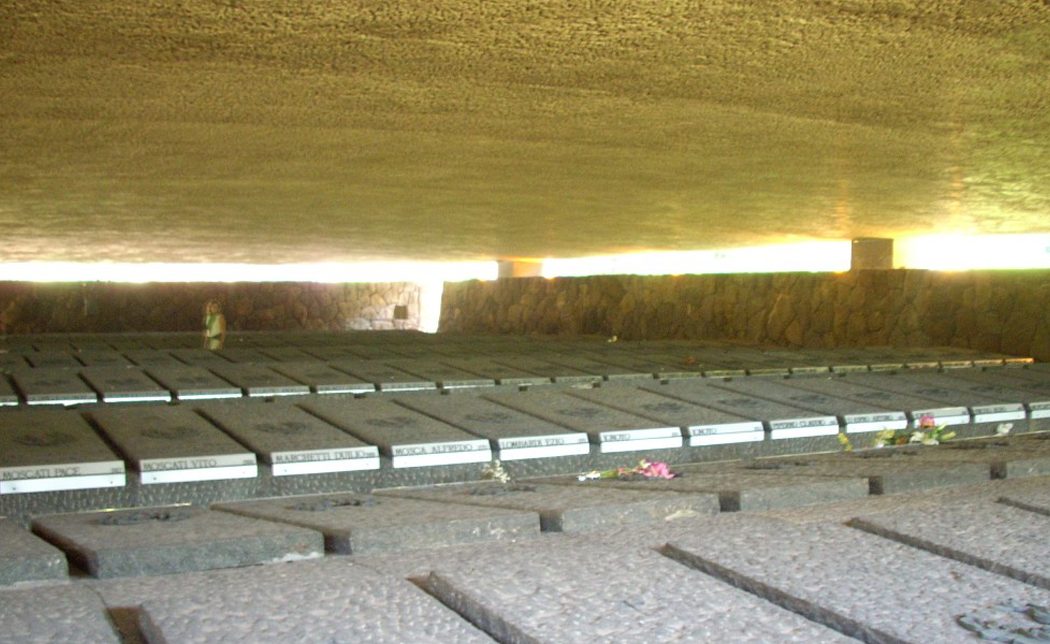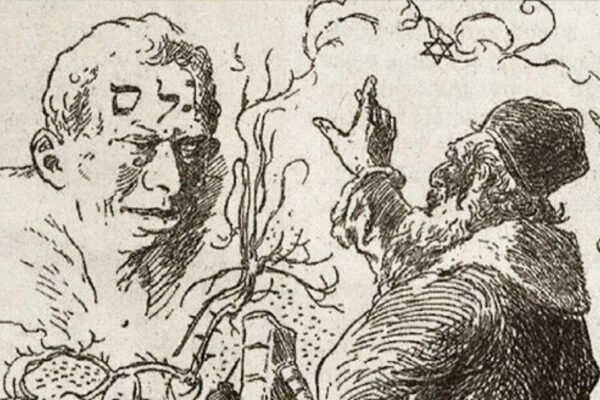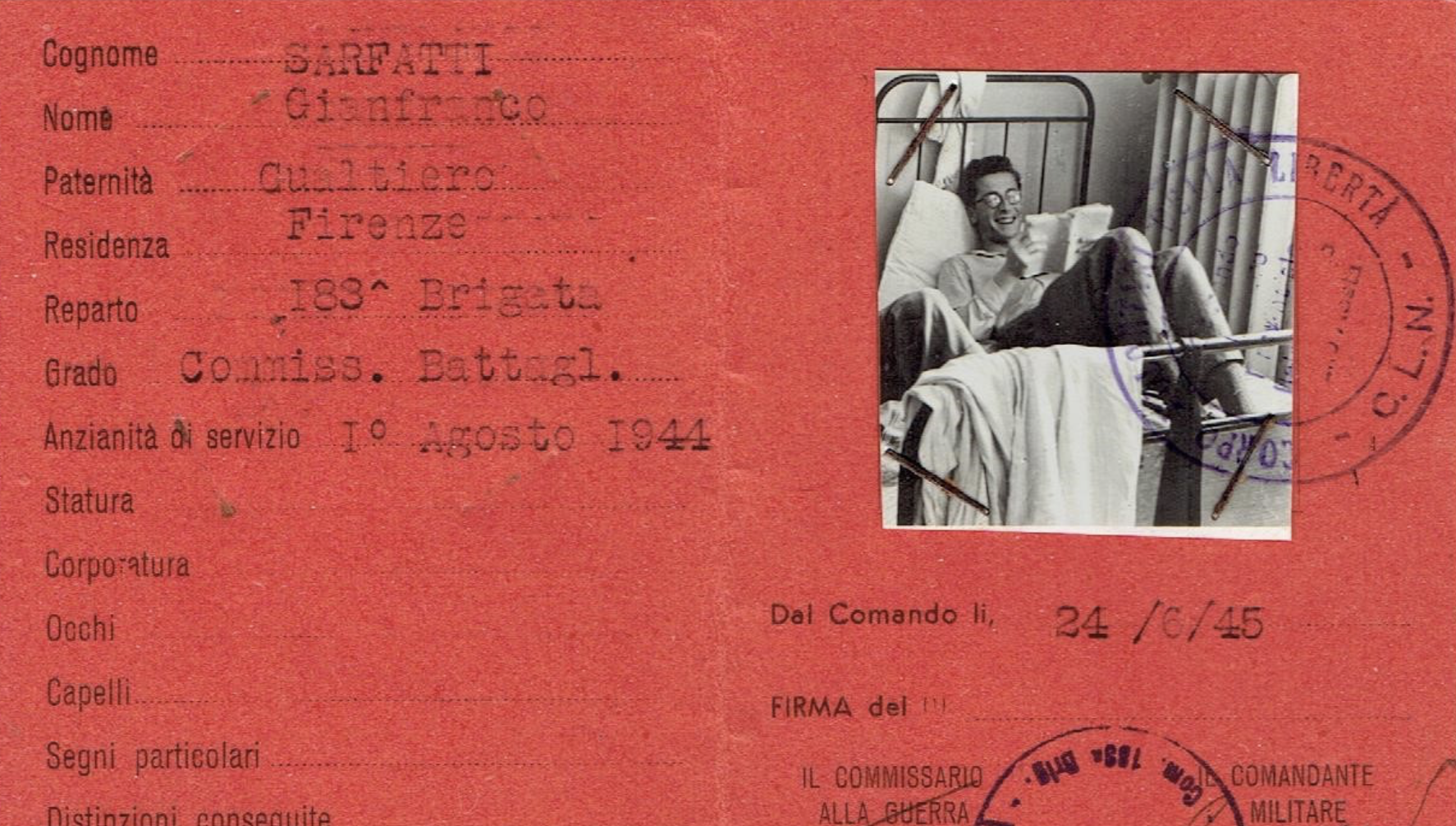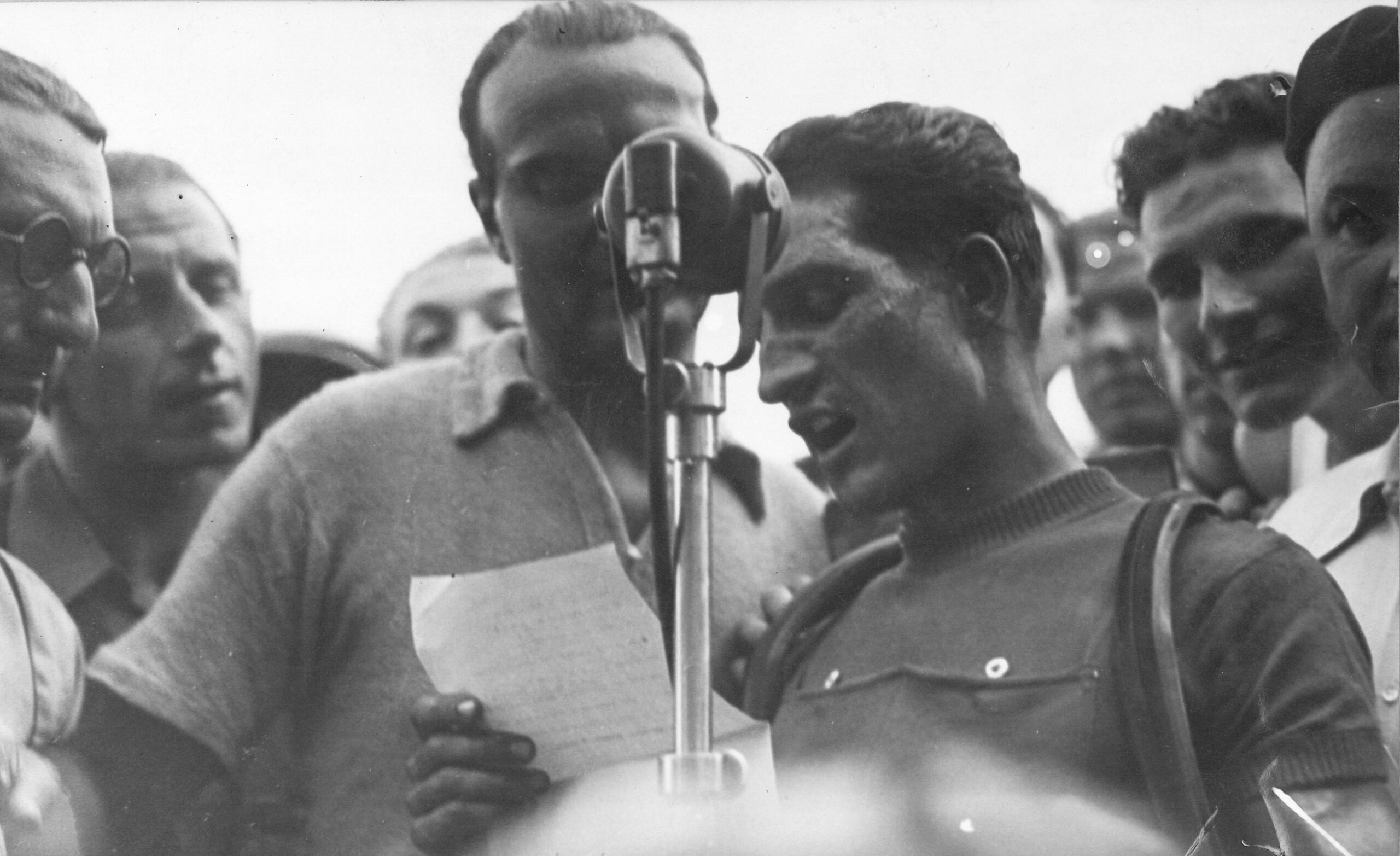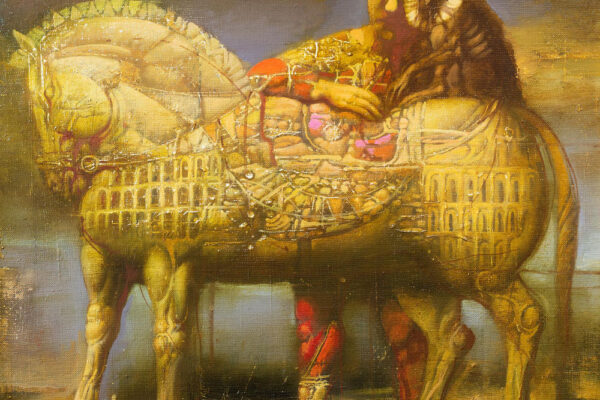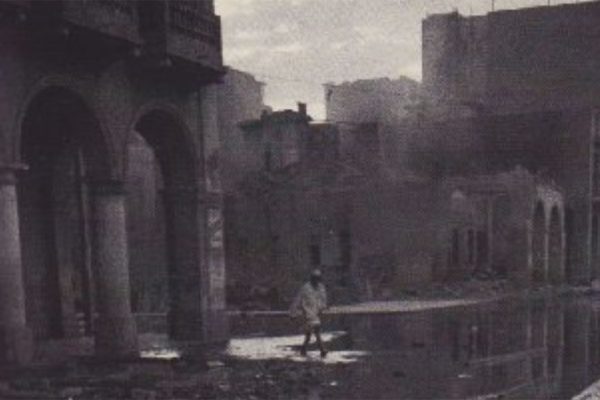The Massacre at the Fosse Ardeatine. History, Myth, Ritual, and Symbol
Alessandro Portelli (born July 8, 1942) is an Italian scholar of American literature and culture, oral historian, writer for the daily newspaper il manifesto, and musicologist. He is currently a professor of Anglo-American literature at the University of Rome La Sapienza. In the United States he is best known for his oral history work, which has compared workers’ accounts of industrial conflicts in Harlan County, Kentucky and Terni, Italy.
Portelli’s 1991 book based on his oral histories, The Death of Luigi Trastulli, analyzed the different press and oral accounts of the killing of a protesting union member.
In 1999 he published L’ordine è stato eseguito [The Order Has Been Carried Out], on the 1944 Fosse Ardeatine massacre by Nazis in Rome, in which he debunked the prevailing narrative on the massacre. The book has become a classic and won the prestigious Viareggio Prize and the Oral History Association award.
From 2002 to 2008 he was the Mayor of Rome’s advisor for historical memory, and he served a year (2006–7) on the City Council of Rome.
Over the course of seventy years, national memory, historiography and the justice system have shown profound ambivalence towards any real assessment of the Fosse Ardeatine massacre.
Outside of the saga of Kappler’s escape, Pribke’s trial and the farce that followed his death, the massacre has catalyzed national sentiments that have more to do with the internal conflicts of Italian society than with the event itself and its victims.
Consequently, formal historical inquiry and an understanding of the interplay between what we can reasonably assume as fact, and what happens in the realm of memory – including imagined events and false memories – becomes central to any attempt to seek justice individually or collectively.
The specific matter under discussion here is the killing of 335 people – hostages, or simply people randomly picked up off the street – by the German occupying forces in Rome on March 24, 1944 in retaliation for a partisan attack the British official record consistently referred to as a “bomb outrage” on the previous day – March 23, 1944 – in which 32 German soldiers had been killed.
This event, this massacre, resonates both backwards and forwards and somehow succeeds in illuminating a whole century of not just the history of Rome but that of the country as a whole, despite lasting only one day. It elucidates history through the people involved and at the same time illuminates memory, due to the fierce controversy it provoked not just within historical record but across successive generations of the general population as well.
Let me begin with two narratives. The first is a British official document, summing up the sequence of events on the occasion of the criminal proceedings against the German commanders in 1946.
According to this report, the course of events was as follows:
At approximately 15.00 hours, on 23rd March, 1944, as a party of German police were marching along the Via Rasella in Rome, a bomb was thrown from a nearby house causing the death of 32 German policemen, and injuries to others. As a result of this outrage, it was decided by the accused, von Mackensen, Commander of the 14th Army and General Kurt Maeltzer, Military Commander of Rome, to institute reprisals against the population of Rome. Ten Italians were to be shot for each German killed; the reprisals to be carried out within 24 hours of the bomb outrage.
According to a June 1944 report in British Home Office Records.
At 14.00 hours, 24th March 1944, the persons to be shot were transported by lorries, in relays, to the Ardeatine Caves, in batches of five. They were taken inside the caves, and shot in the back of the head by SS men. At the termination of the massacre, it was found that 335 persons had been shot, which exceeded the original ratio of 10:1. The caves were then mined. No warning of the reprisal was given to the public, and enquiries by the German authorities to find the persons guilty of the bomb outrage were not completed until long after the massacre had taken place.
Now this is quite an accurate account (actually, the bomb was not thrown from a window – but that need not concern us now). The point to be emphasized in this report is that no warning of the reprisal was given to the public. It was carried out immediately – within 24 hours – and the purpose of the German authorities was not to punish the perpetrators, but to punish the city. So the response needed to be immediate and as severe as possible.
The other story is a personal anecdote. I had just been awarded a literary prize for my book on the Fosse Ardeatine, and I called my wife who was at the hairdresser’s. She told the people in the hairdresser’s the news, and the woman sitting next to her said, “What was the book about?” “The Fosse Ardeatine”, my wife told her. “Oh,” said the woman, “I know all about it!” (This is what everyone always says. You mention this episode, and immediately, memories and emotions flare up.) “I know all about it. It was those partisans who threw the bomb, and then went into hiding who were to blame. And the Germans looked for them. I remember the bills they posted all over the city. ‘If the perpetrators turn themselves in, we will not retaliate. But if they do not turn themselves in, we will kill ten Italians for each German’”.
In fact, this is not the way it happened. There was no warning to the population, no attempt to catch the partisans, no invitation to them to surrender themselves to avoid reprisals. But this woman’s version of the story is the one that has prevailed in public memory; it is the way people remember it. In claiming that she actually remembered seeing the bills, despite the fact that they never existed, this woman was merely one among many; the story as she reported it is ubiquitous. What I’d like to explore, then, is the meaning of this intensely remembered and dramatically misremembered event, and ask how we are to understand the gap between what actually happened and the many ways in which it has been remembered.
It is particularly striking that although the facts have all been a matter of record for more than half a century, they have been consistently ignored; what people remember is the myth of the German search for the cowardly partisans who hid away and allowed the hostages to be killed.
There’s a huge gap between the historical and judicial record (not to mention the accurate memory of a number of first-hand witnesses, including the survivors, the families and the relatives of the victims) on one side, and the distorted, exaggerated, mythologized, communal sense memory on the other. And within this space lies all the complexity of national identity, the foundations of Italian democracy, the politics of memory, and the interplay of institutional and personal memories.
In the title of this article I called up four terms: History, Myth, Ritual and Symbol. These things of course cannot be wholly separated, but they will serve as points from which to explore the question of the meaning of this tragedy.
Let’s begin with history. When I began to be interested in this event, and started telling people that I was thinking of doing an oral history of the Fosse Ardeatine, many reacted with advice and suggestions for additional things to do. Some told me I should research the deportation of the Roman Jews, for instance, while others thought I should start with the 1938 Race Laws, which instituted discriminations against the Italian Jewish population. I decided to begin even before that: in 1870, when Rome became the capital of Italy. For the location of the massacre, in fact, is one of the reasons for its significance. After all, it was not the worst Nazi war crime committed in Italy: there were much worse ones, and with many more victims. It was not even the worst committed in Rome; almost 2000 deaths resulted from the deportation of the Jews. Nor was this an isolated case. In the Public Record Office in London there are records of the investigations of 145 massacres by British Forces in Italy, and that list is not complete.
What makes the Fosse Ardeatine massacre so resonant is that it happened in the country’s capital.
And, in fact, it was the only such massacre to have happened in a large metropolitan urban context, as opposed to a village or a rural area, in Europe. This was a metropolitan massacre, which meant a fundamental difference in the nature of the victims. In most other cases, the victims belonged to a relatively homogeneous group, which is to say as homogeneous as a village population would be.
What makes the Fosse Ardeatine massacre so historically and symbolically powerful is the absolute heterogeneity of the victims.
Here was a cross-section of Italian society at large. Geographically, these men came from all over Italy: I have travelled to Milan in the North and to Salento deep in the South to talk to relatives of victims. They came from all over Italy, because people came from all over Italy to Rome: Rome was a magnet.
Also, because it was a big city, people came from all social classes. There were Piedmontese, Neapolitans and Sardinians; Catholics and Jews; aristocrats and peddlers and members of every social class in between: from professional middle-class lawyers and doctors to the urban working class factory and construction workers. The victims’ ages ranged anywhere from 14 to 74.
The whole spectrum of political opinion was also represented, beginning with the basic distinction between those who were involved in politics and those who were not. Most of the victims were taken from among the political prisoners that the Germans had on hand at the moment of the attack; but since they were too few to make up the number they had decided on, they picked up random people off the street. When they still found a shortfall, they added the “Jews awaiting shipment”, as the British document quoted above states, “to Germany”.
So the dead included both the political and the non-political. And within the group of politically committed persons too the political range was broad, from monarchist Army officers, to ultra-left Communists of Bandiera Rossa – the Leftist splinter group that lost 60 members to the massacre. There were Communists, Socialists, Liberals, and Christian Democrats among the victims, and even a former member of Mussolini’s Cabinet, a Jew who had become an anti-Fascist and worked with the Resistance. The people who died in the massacre were a cross-section of the city, and thus of the whole country.
Today, history has been replaced by myth, and above all by the question: who is to blame? This is what feeds the myth, a myth that is key to any historical debate about the nature of the Resistance in Italy. Italy is that rare nation where, fifty years after the fact, it is still arguing over whether its freedom fighters were criminals or heroes; a place where the question of whether it was a crime to attack a marching unit of uniformed police attached to the SS, belonging to a foreign occupying army, can still be a matter of debate
In one sense, this could be seen as the flip side of a positive aspect of a national trait: Italians, historically, have not been a warlike people and perhaps for this reason any attempt to imagine the partisans as “war heroes” has never fully succeeded. Another significant factor in how this event has been remembered is the fact that those who carried out the attack were Communists, and whatever Communists do, especially from a late 20th /early 21st century perspective, is a crime. Anti-Communism reinforces the idea that this was a criminal action, a new attack. And the myth is a very tenacious one. When my wife at the hairdresser’s tried to persuade her neighbor that she was wrong, saying that her husband had just written a book about it, and the popular account was not accurate, the response was, ‘If he had talked to me, he wouldn’t have written it!’ It is a myth entirely resistant to historical information.
The action in via Rasella was a very well organized military action, in which 18 partisans took part. Yet the myth has it that it was the act of a single person – which in itself turns a military action into a terrorist act – and that he felt so guilty after killing those poor SS men that he subsequently committed suicide (the person to whom this act is attributed is, contrarily, still alive).
A further aspect of the myth holds that the whole affair was not the fault of the Germans. This itself is based on yet another myth, or a national stereotype: the Germans are stern, but just. They had their rules and they carried them out. And the ratio of 10:1 is so geometric, so perfect, that it only confirms the sense it all makes. According to this logic, “The poor Germans had to do it, because this was the stern law of war, applied by a stern people. They were stern, but coherent”. Whereas the partisans, on the contrary, are represented as being underhanded, secretive and cowardly. As though their actions were sneaky, as if they would not take responsibility. At the heart of this interpretation, I suggest, is the continuing struggle over the question of what kind of Italy emerged from the ruins of the World War II. The founding narrative of the anti-fascist Italian democracy was the idea of ‘the Republic, born out of the Resistance’; and however banal this phrase had become, it nonetheless had a certain truth.
Many of the values of the Resistance are embodied in the Italian constitution. But if the idea of the Resistance, and of the heroism of the partisans, underpinned Italy’s post-war democracy, then, of course, the anti-partisan version, the version which holds the partisans to blame for the massacre, is the counter-myth generated by the unfinished quality of our democracy. The democracy that came out of the Resistance was not the unanimous choice of the majority of the people, but rather a project, a plan, a dream; and a dream that not everyone shared. There was also a resistance to democracy itself.
So the question becomes: is Italy an anti-Fascist democracy born out of resistance, or is it something else?
A large section of the Italian population would not accept the anti-Fascist ethos that was, in theory, the inspiration of the Italian Republic.
The most important institution in the country – the Church – was the first promoter of this distorted memory. It originated with an editorial in the Osservatore Romano, the official newspaper of the Vatican, on the front page of the issue of March 26, 1944, and, when the Osservatore Romano said something, priests all over the country repeated it. The Church inherently refused to take sides. In theory it was neither for the Fascists, nor for the anti-Fascists. This meant, however, that the Church was not on the side of the anti-Fascist. This was also the case with the Christian Democratic Party, which ruled Italy for 50 years.
One of the most fascinating results of this mythical narrative has to do with chronology. Time is crucial in this episode. The retaliation was carried out within 24 hours and the population was not informed of the partisan attack until after the massacre. However, if you ask anyone between 14 and 80 how much time elapsed between the partisan action and the massacre, the answers range from three days to six months. One of the reasons is that in order to blame the partisans for not responding to the summons, one needs to give the Germans time to look for the partisans and ask them to surrender.
Since this myth has been challenged, at least in terms of public discourse, alternative narratives have emerged.
There is a whole series of misinterpretations. Myth, here, functions as an interchangeable set of stories that all support a preconceived conclusion: “The Communist partisans are to blame”. So once it’s made clear that there never was a question of subordinating the massacre to the delivery of the partisans, the new version of the myth is: “They should have turned themselves in anyway whether they were asked to or not, whether they knew of the retaliation or not”. Or one especially popular these days: “They should have known what the consequences would be. The Germans are like animals. They’re like wild beasts. If you provoke them, they will react.”
Part of this myth, in fact, is the anti-German stereotype: “The Germans are beasts. The Germans are machines”. But in reality, the Germans are human, and theirs was not a knee-jerk reaction, but a carefully thought-through political decision. The myth that the partisans “should have known” is based on another assumption: that this was the only armed action in Rome in which Germans were killed. This is also not true. Via Rasella was the 43rd attack that took place in Rome against the Germans. The belief that there really was no Resistance in Rome, and therefore the attack in via Rasella was an isolated event, a provocation in an otherwise tranquil city, is a myth with a meaning. It is both in harmony with the stereotype of the lazy fatalistic Roman, and functional in helping make Rome the Conservative capital of a Conservative government; since there was no Resistance in Rome, the suggested logic goes, it was only a few madmen who planted a bomb.
Actually, there was a great deal of resistance, both active and passive, armed and unarmed. According to the German Commanders, Rome was “not co-operating”; therefore, they needed to punish the city. The basic reason why retaliation had not taken place before was that previously the Germans had preferred to keep things quiet. They controlled transportation had broken down in Rome, so the news of other partisan attacks did not circulate.
The Germans relied on the myth of their invulnerability and invincibility to keep the city quiet. But the attack in via Rasella was too public. It happened in the middle of the day, in the center of town. They couldn’t hide it. It was a visible crack in the armor of impenetrability of the occupying army, and something had to be done about that – immediately. In fact, some versions of this narrative claim the partisans carried out the attack with the precise aim of ensuring retaliation: “They did it on purpose. They did it so that the Germans would kill prisoners who belong to different parties, or so that the Germans would retaliate and it would start a rebellion”.
As regards the matter of memorial rituals around this event, it is clear there are tensions surrounding the distinction between what is both a collective massacre – 335 people killed – and at the same time 335 murders of individuals. These two different ways of seeing have very different consequences. The collective massacre generates public memory, monuments and ceremonies; the 335 single murders generate subjective memory, personal loss.
Since the only thing the victims had in common was that they were all men, the bearers of memory after the event were mainly women: wives and mothers – and a few fathers; but it was predominantly a woman’s story. And the conflict between monument and personal memory emerged very quickly.
Rome was liberated in June1944. The Allied Command proposed that since the victims of the massacre had already been buried, a monument should be built on top of the burial site in commemoration. But the relatives – the wives, mothers and daughters – protested.
This is how Vera Simoni, the daughter of an Air Force General who was killed there, described her mother’s reaction:
“And so this is where my mother steps in. My mother said ‘No’, because otherwise we’d still be waiting for our father to come back. She said, ‘No, I want each of them to be recognized’. So she talked to the officers, and they said, ‘Madam, we’d like to do what all you ask, but it’s impossible. It can’t be done.’ So mother and I, and my sister, we went to see General Pollock, who was the Head of the Allied Forces, and he received us right away.
And my mother said, ‘Look, we’ve come to ask for this. We know you’re going to make this monument, and we refuse to accept it. We want recognition, body by body’.
So he says, ‘Well, it’s going to be difficult’. But my mother had already spoken with
Dr. Ascarelli, who was a pathologist, and Ascarelli had gone to the place and he said,
‘It’s a crazy idea, but it all can be done, and especially if the desire and the need is so strong’. So my mother said, ‘No, it can be done, because we spoke to the Professor, it can be done’. So General Pollock said, ‘Well, listen, let me think about it’. So he took us to the door and I said these words too, as well as my mother, ‘Look, we don’t give up. We don’t want anything. We want nothing for ourselves. We just want them to be identified, because all the other families are in the same situation as us’, and, in English, ‘We don’t give up’”. [Vera Simoni, b. 1922, daughter of General Simone Simoni, killed at the Fosse Ardeatine 1944; int. April 5, 1998].
Such situations highlight the difference between putting someone under the earth and really burying them: having a ceremony where their death is recognized and is becomes something of value, as Ernesto de Martino says: it acquires a meaning. Before this, the families did not know what had happened; as in any case where many people have been deported or have disappeared, they could not be sure what had become of those they had lost. And it was largely the women – who started going around asking questions, trying to track down their missing loved ones – who resolved it.
The dead had to be unburied in order to bury them again; and they had to be identified. They had been there for months. They were killed in March; the disinterment began in July, and went on until the end of September. The bodies as they were uncovered were heaped on top of each other, because there wasn’t enough room in the cave to lay them out. Later victims had been forced to climb onto the bodies of those who had been killed before them, in order to be shot.
The bodies were recognized by the clothes they wore, and by other details eventually revealed in photographs and papers. This process of identification went on for months and months. Meanwhile, their memory was being appropriated by the public; it was becoming a national memory.
Thus, two types of ritual emerged. First were the private responses: how should the dead be mourned? In 1944 Rome was a very southern city, its population largely made of first-generation immigrants from the rural South. They brought an extremely emotional way of mourning the dead, described in a number of ethnographies in Southern Italy, involving weeping and losing control, just letting go.
Carla Capponi, a partisan who accompanied the wife of one of the killed, recalls:
“All her relatives were there, her son was there, and I realized this was a hellish place, because all the parents had to recognize those pieces of bodies. And it was a frightening scene. They were screaming as they carried out these bodies. What can I say? It was a tragedy you didn’t know how to resist, to see the trembles.
I think tragedy has to be taken literally here, because the voices, the gestures, are the voices of the ancient Mediterranean theatre – archaic Greek and Southern Italian theatre.”
At the same time, Rome was a middle-class city, and kept to the middle-class type of mourning – self-control and keeping it all inside. There are many stories of repressed anguish, of people who were unable to weep until years later; and then when eventually they did weep, their middle-class children stared at each other, shocked at such a display of emotion – especially shocked to see their parents falling prey to emotion at all.
Alongside the private mourning, however, was the public monument. The monument that was built is beautiful. In the ceremonies around it, the desire was to spiritualize, and make this appallingly palpable story abstract. How to do this at the height of the Cold War, when the Communists all of a sudden were the enemy and the Germans allies, was an especially delicate question.
The Communists were closely identified with the Resistance, to the extent that for a long time there was almost a suppression of the non-Communist element; and while the post-war Communists were, on the whole, happy to go along with this, since it gave them something of a monopoly on martyrdom, on the other hand it also served to confine the Resistance to a left-wing ghetto, giving it a very ambivalent position in post-war politics. Yet the armed forces – the Carabinieri, the Army and the Air Force – were active in patriotic resistance, and they had lost a number of men at the Fosse Ardeatine; but these victims are hardly remembered. The institutions of the Italian State preferred not to remember the fact that they had been involved in the anti-Fascist and anti-Nazi war, for a number of reasons.
In the event, the solution was to entirely depoliticize the official ceremony. Public memory fell under the sway of religion and the military. Now every year, on the morning of March 24th, there is a Catholic ceremony, a Jewish prayer, and a couple of military maneuvers. Labor organizations follow in the afternoon with their red flags.
In the middle of all this were the individuals who didn’t know what to do next, weeping for their fathers, their brothers and their sons, not for heroes. None of the official speeches had mentioned who killed the victims. They simply “gave their lives” or “sacrificed themselves.”
They hadn’t; but the heterogeneous nature of the group gave rise to further problems. If some of them had voluntarily put their lives on the line – the partisans, for instance – others had not; the Jews, or those victims randomly picked up off the street, had never elected to risk their lives. So while all can be called martyrs, or indeed heroes, they cannot all be termed innocent; many of them had engaged in something knowing it put their lives at risk. As one son said, “My father was no innocent. He had tried to fight the Germans”.
And a daughter similarly asserts, “I don’t want to be the daughter of an innocent victim”. There is no unifying category there, unless the very abstract and harmless category of “martyrs” of freedom, or “martyrs” of liberty. The options they actually faced are barely mentioned.
Alongside accounts of the Resistance characterizing it as a wing of the Communists, so to speak, a different myth arose, one that saw the Resistance as a united movement involving the majority of the Italian people. The notion this provoked – that everyone therefore had to be represented in it, led to a search for the simplest common cause; which in this case emerged as patriotism and democracy.
The Communists themselves went along with this drive to represent the Resistance as something harmless and uncontroversial, not least because in the middle of the Cold War they had to legitimize themselves as not merely a legitimate element of Italian democracy, but part of its foundation. So the fact that the Resistance was a conflict was played down, as was the fact that partisans were armed fighters who had not only died, but also killed. All the monuments to the partisans are monuments to dying partisans.
As a historian recently said, “The Resistance is the only war which is celebrated for the battles it has lost, rather than the ones it has won, because the ones that it has won would remind us that it was a war”.
Thus the surviving partisans who took part in the attack in via Rasella lived the the rest of their lives with a sense that while the Communist Party defended and supported them, it never really owned their action. In fact, a number of anti-partisan versions, like the version, “They should have turned themselves in”, are widespread among the Left as well.
How did the survivors, the families, go on with their lives? This is the question that initially led me to work on this project. In 1994 one of the perpetrators, the SS Captain Erich Priebke, was tracked down in Argentina, extradited to Italy, and tried for his crimes. The whole controversy flared up again. As the relatives came forward, it appeared – on television, in the press and across all media – as if the massacre were really a private matter, concerning the Nazis – the perpetrators – and the victims – relatives of the dead and the Jewish community at large. What it was not was something for us good people to worry about any longer, however much we might sympathize with the victims – which were now to be regarded as frozen in time.
Of course, they are, in a way. Guiseppe Bolgia, the twelve-year-old who identified his father, says, “It’s like yesterday”. On the other hand, they have lived on since then for more than half a century. How did the survivors get through life, with their grief and their memories?
Following the massacre, the visibility of the widows, dressed in black as they moved throughout the city, was regarded as almost a disturbance to other citizens; their presence disruptive to the consensus being constructed – although it was permitted to be sympathetic from a distance.
Ada Pignotti was 23 years old. She had been married six months. She lost her husband and three other relatives, and she says:
“Well, back then, after it happened in ’44, you couldn’t really talk about it. You just couldn’t talk. I worked for 40 years, so even in my office, sometimes when they asked me about it, I wouldn’t talk because they … they respond arrogantly. They said, ‘Oh well, blame the one who threw the bomb’. And I pretended that I didn’t hear them, because they always answered that way. Or, ‘It’s not the Germans’ fault, it’s the fault of the one who put the bomb there, because if he had turned himself in, they would have killed him’. Well, who wrote the story? When did they ever say this?
“It never happened. They didn’t warn us. They didn’t post any bills. They put them up afterwards, after they’d already killed them”.
This distorted memory, which is how the city chose to make sense of what happened, is also a way of exorcising her, of refusing to share her pain.
The visibility of the widows brought other troubles too. In 1944, women weren’t supposed to go out to work. These women going out into public spaces were assumed to be defenseless.
Having no man, they were fair game. Many were subjected to sexual harassment – something that didn’t even have a name at the time – on top of what they had suffered. Several of the women have these kinds of stories, which reveals a lot about what Italian male culture was at the time. There are also stories of mutual aid. For instance, a woman who had lost her brother tells how she would go to her sister-in-law’s house, and secretly put a soothing pill in her sister-in-law’s soup; later she realized that her sister-in-law was putting a pill in hers. Then there are the stories of children growing up surrounded by the pain of their parents. “It was a strange grief”, a woman who lost her father says, over and over. “It was a strange grief”. She describes calling her mother, in the mid-sixties, and asking, “Mum, what are you doing?” Her mother replied, “I’m weeping”. “What are you weeping for?” “I’m weeping for your father”. And the daughter said, “Now?” Her mother answered, “I didn’t have time before, because I had to work. I had to keep three jobs, keep house, raise four daughters, now I’m retired, I can weep”.
Some children grew up in orphanages; those who could stay at home were imbued with this trauma, which has been passed on through generations.
Finally, there’s the question of symbols. One of the things I did was interview young people. When you say you’re going to interview young people, older people’s first response is always, “Oh, they don’t know anything. They don’t have any historical memory”. In some cases this is true: they have as little historical memory as their parents and grandparents, that is to say, from whom they have learnt the wrong version of events, which they repeat.
Others, fortunately, have no version at all. I say fortunately because they don’t know the wrong version; there is nothing screening them from the knowledge of what really happened and its meaning. Thus many young people do not make that automatic connection between the attack and the massacre, as cause and effect. They do not shift their gaze away from the fact of the massacre. They may have a hard time historicizing it, because they don’t really know what was going on; but they symbolize it beautifully.
“The story, honestly, I don’t really remember it”, one high school student told me. “I don’t remember it very well, to tell the truth. But the name makes me think. I know it makes me think, ‘Fosse Ardeatine’”. (The word ‘fosse’ is significant in this train of thought. The “Fosse” were originally called “Cave” – which is the Italian for ‘quarries’ and which means ‘caves’ also – which is why they’re known as ‘caves’ in English (as well as because they were underground).
Soon after the War the name was changed to “Fosse” which means “graves”, but also “ditches”.) So he continued, “Fosse Ardeatine. And I have this image of this huge ditch where they dumped people. What I imagine … this is what I imagine. A place where people are dumped, mutilated, massacred”. “Like trash?” I asked him. And he said, “Yes, exactly. Like trash.
“Taken and thrown away, as if they were sacks of potatoes or things. You know what it makes me think? It makes me think of the annihilation of the value of life. This is what it makes me think of. Man treated like a thing, like a piece … I don’t know, like a rag”. This description is uncannily right: “like a piece”. We all remember that the Nazis called the prisoners that they deported to the extermination camps “stücke” – “bits” or “pieces”. And in the Fosse Ardeatine they tried to cover the caves with trash, in order to hide the stench that was rising out of these bodies.
So what do young people see here? They see an image of absurd death, of sudden, casual death, death that is not the result of any natural process. And this ties in with their own experience of death. What I’ve realized, in doing this book, is that my generation, the one that grew up in the post-War boom years, was exceptional in the sense that it was a generation in which death was invisible. The death of young people was very exceptional; the middle-class ethic of hiding death from children prevailed. For today’s young people things are different.
There were three suicides in my older son’s high school class. There are at least 12 markers made by young people, with flowers, photographs and soccer cards dedicated to their contemporaries who died in road accidents on the street where I live. They know about deaths from drugs too. So they are familiar with death.
But since the older generation still believes they know nothing about it and should be protected from exposure to it, nobody helps them deal with death; so they have had to come to terms with it on their own.
The Fosse Ardeatine is a national symbol. An outing to the Fosse Ardeatine is a typical school trip. Sometimes the kids make a joke out of it; sometimes they’re truly shocked and moved. But what is shocking and moving is no longer anti-Fascism, or any other political cause; it’s the presence of death.
The pioneering book on the Fosse Ardeatine massacre, by Robert Katz, was called Death in Rome, (Morte a Roma, Editori Riuniti, Rome, 1967) I think it’s a very appropriate title, but one with a broader relevance than he perhaps intended. It’s really about the meaning of death in a modern city, and the meaning of the memory of death.
So I’d like to close with a brief narrative on death, memories, ceremony, and the feeling of history. The monument to the victims of the massacre is also a cemetery; there are three hundred and thirty-five concrete graves in one large room, raised from off the ground, and the concrete slab on top, a huge stone ceiling with a slight opening.
One of the few men – is a son, Modesto De Angelis:
I was always somehow bothered by the commemorative ceremonies, even though I wasn’t directly involved and could be an anonymous member of the crowd. I didn’t have to go up on stage where the relatives were displayed, so somebody could point at me and say, ‘He’s the son of one of the victims’. But those official, ritualistic words, they were so tired, and so tiresome. Then one day I happened to visit the monument on a spring morning, at nine, when it opens to the public, and nobody was there. After that I always went there at that hour.
The shrine is covered with a huge stone. In the spring sometimes, there are a few birds that sit on it and sing. I used to go there sometimes and say a prayer, and speak – in a low voice, even though I was alone – to those dead, who I always called ‘my boys’. And if there is something that still makes me bitter after all these years, it’s that I was never able to go there one day and tell them, fully believing it.
‘Well, we made it. You made it’.


